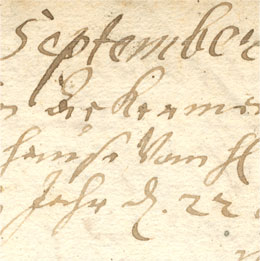When was the Juuru Church pulpit completed, who worked together on it, and where to did its painter disappear?
The Juuru Church pulpit was completed in the latter half of the 1690s. The name of the cabinetmaker who fashioned the architectonic parts of the pulpit’s corpus, stair balustrade panels (which have perished), door portal, and sounding board is not known. Along with his assistants, Christian Ackermann was the carver of the figures and ornamentation decorating the work of the cabinetmaker.
Ackermann probably entrusted his assistant with carving the figure of John the Evangelist. For this reason, this figure turned out bulkier than others. Its face is flatter, and its hands, feet and clothing are carved more clumsily.
Ackermann made only two of the putto corbels that support the pulpit’s twisted colonnettes. Additionally, he made the large putto head above the door portal. The puttos made by his assistant, who was less skilled than the master, turned out to have flat, broad foreheads and thick noses, while the feather covering of the wings of the puttos was more ungainly.
According to the Juuru Church chronicles (first half of the 18th century), the pulpit was initially left unpainted. ‘There is a pulpit in the church that has been completed as the work of a good sculptor, which the blessed Mannrichter (district court judge) Reinhold Engdes gave to the church as a gift. It has not been painted yet: Hakenrichter (the chief of police of the local rural district) Toll von Hördel (Toll from Hõreda Manor) has promised to have the pulpit painted.’
Leaving the pulpit unpainted for decades was exceptional in the context of Ackermann’s oeuvre as well as in the broader context of Estonian ecclesiastical art. (Such instances are rare throughout the baroque era Baltic Sea cultural space). The reason for the absence of polychromy on the pulpit could have been a lack of money.
What does the Juuru Church pulpit’s iconography speak of?
The pulpit’s iconographic programme (which was altered in the 19 th century) was originally simple and clear: four evangelists and in between them Christ as Salvator Mundi are depicted on its corpus. Moses stood beneath the corpus as an illustration of the cohesion between the New and Old Testaments. Christ the Invincible and angels bearing the attributes of Christ’s Passion stood on the sounding board. The congregation was meant to understand the pulpit’s figurative language as an embodiment of Martin Luther’s favourite theme – the union between the law and grace.
What is surprising about the history of the Juuru Church pulpit’s staircase and polychromy?
As has already been said, the Juuru Church pulpit initially remained without polychromy, and it was only in the mid-18 th century that it was finally painted. Yet the pulpit’s coat of paint from the final decade of the 19 th century, which has survived to this day, is altogether more surprising than the first coat of paint. As can be read from the panels on the inner side of the pulpit’s corpus, the pulpit’s renovators were the cabinetmaker J. Johanson, the painter Kalff, and the ‘artist damoiselle’ S. v. Kügelgen. Kügelgen had family ties to Juuru Parish. She approached sculptural and relief art as a professional painter. She painted figures and carved scenes as if she were creating a painting. The Baltic German female artist Sally von Kügelgen was from the famous Kügelgen artists’ dynasty and had also previously worked on decorating churches – for instance, she created three apse paintings for Tallinn’s Church of Charles XI.
The comprehensive renovation of the pulpit was undertaken in connection with the reconstruction of Juuru Church, which was carried out in 1893–1895 according to the design project drawn up by the architect Erwin Bernhard. The cabinetmaker J. Johanson carved the (first two) reliefs according to either photographs or sketches made by the painter Sally von Kügelgen.
The pulpit was moved to a new location – in front of the chancel arch – after its renovation. It consequently lost one of the sides of its corpus and its figures were rearranged. It was given a new colour scheme and a stair balustrade with noteworthy carved panels. Two of the Juuru pulpit’s three stair balustrade reliefs – depicting the birth of Christ and his resurrection – were carved according to the stair balustrade panels of the pulpit of Tallinn’s Church of the Holy Spirit (1597). The third relief depicts an angel bearing a model of the old medieval church flying up into the heavens on the background of Juuru’s reconstructed church, inferring the particular sanctity of handling sacral art.
